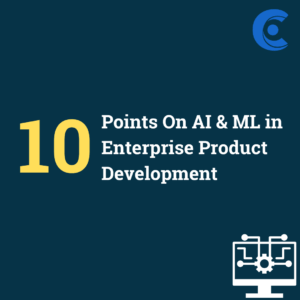10 Points On AI & ML in Enterprise Product Development

1. Product Design:
AI & ML can generate new ideas, suggestions, & prototypes. ML models can be trained on product data to identify patterns & trends, providing insights into customer needs & preferences. AI can optimize product features & improve usability, as well as assist in creating more efficient & cost-effective designs.
2.Product Maintenance & Testing:
ML models can automate testing procedures, identifying issues & bugs more efficiently. AI-powered monitoring & maintenance tools can detect and diagnose problems in the product in real time, reducing downtime & improving overall product performance.
3.Automation:
AI ML can automate repetitive tasks, saving time and resources and allowing teams to focus on more complex & creative tasks. AI/ML increases the accuracy & productivity of the development team.
4.Data:
AI ML automates data analysis & feature engineering, providing insights into customer needs, reducing human error, and ensuring products meet industry standards. Algorithms can extract valuable insights & inform product development decisions, helping to make sense of large datasets & identify patterns, trends, and outliers.
5.Personalized CX:
AI ML can improve the user experience by personalizing products to individual users’ needs & preferences. AI can analyze user behavior and interactions and use ML algorithms to deliver personalized content and recommendations. This can lead to increased customer satisfaction and loyalty.
6.AI-Powered Chatbots:
They can improve customer service & support by providing instant, personalized assistance to customers. They can handle repetitive & common queries, freeing human agents for more complex issues.
7.Data Visualization:
Data visualization is an important aspect of AI/ML in product development; it allows businesses to make data-driven decisions and identify patterns, trends, and outliers in large data sets through charts, graphs, and other visual aids. These insights inform product development decisions and optimize marketing strategies.
8.Performance Optimization:
AI-powered monitoring and maintenance tools can predict when an issue is likely to occur, allowing for proactive maintenance, which in turn reduces downtime and improves overall product performance.
9.Security:
AI can be used to improve the security of enterprise products by detecting & preventing cyber-attacks. ML algorithms can be trained on data from previous attacks to identify patterns & anomalies that may indicate an attack is in progress.
10.Drive Growth:
AI-enabled predictive analytics and intelligent recommendations provide businesses with valuable customer insights to optimize product development, marketing, and sales strategies, leading to improved customer satisfaction, increased loyalty, and growth.
